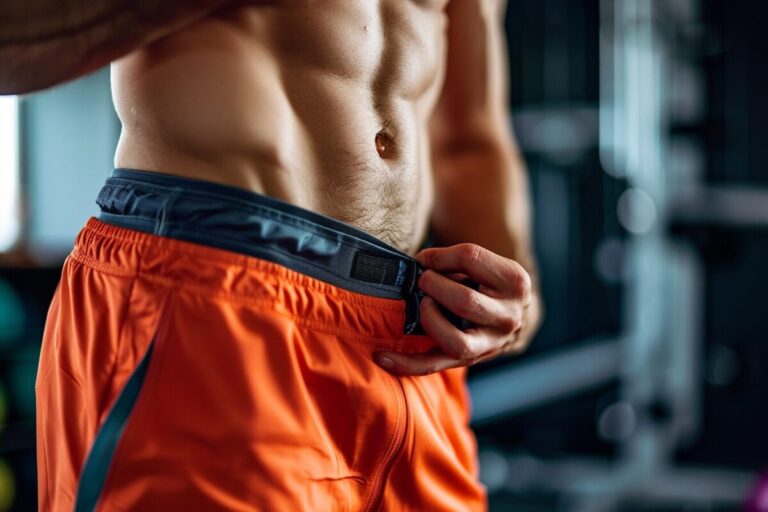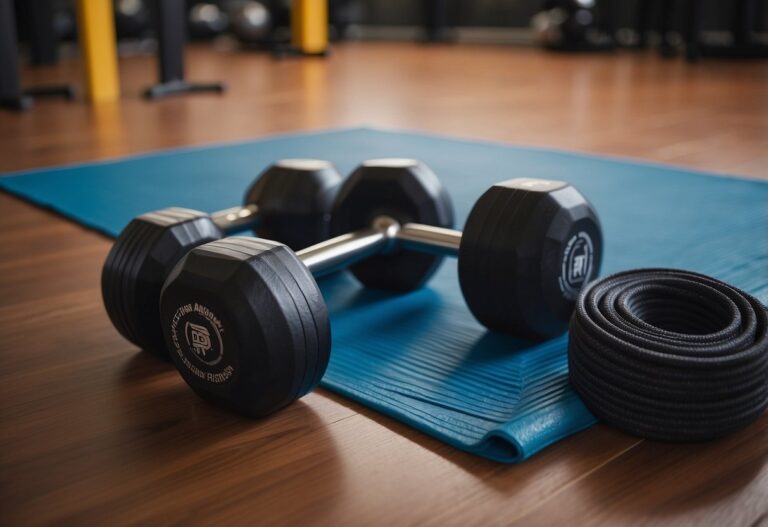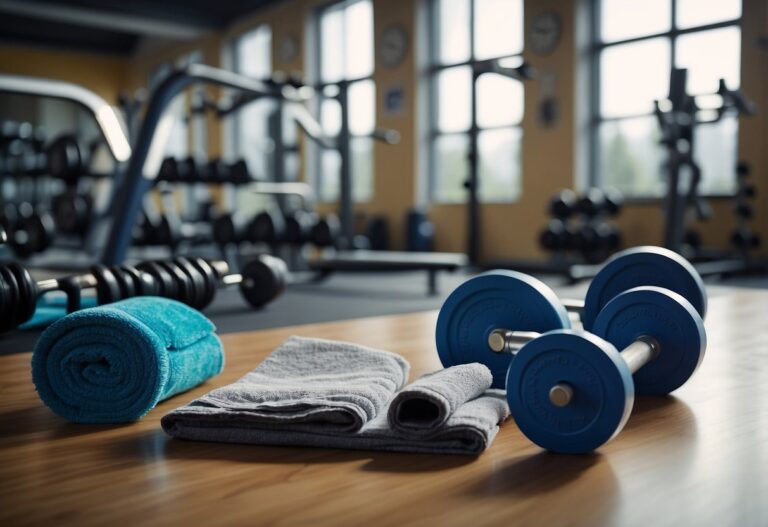Walking into a gym for the first time can be daunting, with unfamiliar equipment and experienced folks all around. It’s normal to feel a bit lost at first, but remember that everyone started somewhere. Knowing the basics of gym workouts can help you feel more confident and make the most of your time there.

Whether you’re aiming to build muscle, lose weight, or just stay active, having a solid plan can make a huge difference. You’re more likely to stick to your routine and see results if you know what you’re doing. Let’s look at some key tips to help you get started on the right foot.
Warm up for 5 minutes
Warming up before you start your workout is crucial to prepare your body and prevent injury. A good warm-up can be just 5 minutes long.
Start with marching on the spot for a minute. Raise your knees high and pump your arms vigorously.
Next, do some bodyweight squats. Stand with your feet shoulder-width apart, squat down, and then stand back up. Aim for 15 reps.
Move on to lunges. Step forward with one leg, bend both knees, then push back up. Do 8 reps on each leg.
Heel digs are simple yet effective. Stand and dig one heel into the floor while pulling your toes up. Swing your arms as you do this for around a minute.
End with some arm circles. Extend your arms out to the sides and make small circles, gradually increasing the size. Do this for 30 seconds in each direction.
By following these simple steps, you’ll be ready for a more intense workout.
For more detailed guidance, you can check out The Best 5-Minute Warm-Up or 10 Best Warm-Up Exercises.
Focus on Compound Exercises
When you hit the gym, focusing on compound exercises can boost your workout efficiency.
Exercises like push-ups and barbell back squats engage multiple muscle groups at once. For example, the push-up works your chest, triceps, and shoulders. It’s one of the best bodyweight exercises for your “push muscles”.
Using weights? Try the barbell back squat. This exercise targets your quads, glutes, and hamstrings. It’s perfect for building serious muscle mass and strength in your legs and lower body.
By incorporating these exercises into your routine, you can save time and get better results. Consider adding deadlifts as well for a full-body challenge.
Maintain Proper Form
Proper form is essential when working out to avoid injuries and get the best results. Imagine lifting weights with a bent back; it’s a recipe for disaster. Your posture matters in every exercise.
When doing squats, ensure your knees don’t extend beyond your toes. This helps in protecting your knees and maximising the effectiveness of the exercise. Think of sitting back into a chair.
For exercises like bench presses, keep your feet flat on the ground and your back slightly arched. This stabilises you and prevents unnecessary strain on your shoulders.
Remember, quality over quantity. It’s better to lift lighter weights with good form than heavy weights improperly. This approach will build strength and muscle more efficiently.
If unsure about your form, consider asking a fitness trainer for guidance. Professional advice can make a significant difference in how you perform each move.
Make it a habit to check your alignment in mirrors available at the gym. This quick visual check can help you correct any mistakes instantly.
Split your routine
Splitting your workout routine can help you target different muscle groups more effectively. For example, you can dedicate certain days to upper-body exercises and others to lower-body exercises. This allows you to give focused attention to each area without overworking your muscles.
Consider a 4-day workout split where you perform upper body exercises on two days and lower body exercises on the other two days.
This approach can help with both strength and muscle growth. Additionally, having a schedule allows for better recovery and prevents burnout. Try experimenting with different splits to see what works best for you.
Stay Hydrated
Staying hydrated is key to maximising your workout performance. It’s simple: if you’re dehydrated, your body won’t function as well.
Before you hit the gym, aim to drink at least 16 to 24 ounces of water two hours prior. This ensures you’re starting on the right foot.
During your workout, keep a water bottle handy. Sip on it regularly every 15 to 20 minutes to maintain hydration levels. This helps replace the fluids lost through sweat.
Don’t forget post-workout hydration. Drink 16 to 32 ounces of water after exercising to replenish your body. Staying hydrated keeps you energised and helps with muscle recovery.
For more details, check out this Fitness First guide.
Listen to Your Body
When working out, it’s crucial to pay attention to what your body is telling you. This means noticing signs like fatigue, soreness, or changes in your mood. These signals are key in helping you avoid overtraining and injuries.
If you feel persistent soreness or extreme tiredness, consider taking a rest day. Rest and recovery are just as important as the workouts themselves. Your body needs time to repair and strengthen from the effort you put in.
Tuning in to your body also means adjusting your workout intensity based on how you feel on a particular day. Some days, you might be able to push yourself harder, while other days, it’s best to take it easier.
By listening to these signals, you can create a more flexible and responsive workout routine. This not only helps you stay motivated but also improves your overall fitness results. Remember, your body knows best.
Incorporate Strength Training
Adding strength training to your gym routine can boost your fitness. Try allocating specific days for weightlifting, just like you do for cardio. A balanced schedule might include two days of strength training, three days of running, and two days of rest or light activity.
Start each strength training session with a warm-up. Fifteen minutes of cardio or dynamic stretches can prepare your muscles. Exercises like jumping jacks or arm rotations work well.
Choose a variety of exercises to target different muscle groups. Use both free weights and machines to keep your workouts interesting. Mixing things up prevents boredom and keeps your body guessing.
Don’t forget to include isotonic exercises, which involve contracting your muscles through a range of motion. These can be very effective for building strength.
Allow adequate recovery between intense strength training sessions. Ensuring you don’t do hard running or lifting on consecutive days helps prevent overuse injuries.
Rest between sets
Rest between sets is crucial for your workout routine. The right rest time can influence your performance and results. Typically, if you’re lifting heavy weights for strength, you’ll want longer breaks. For example, during a bench press, you might rest for 3-4 minutes to fully recover between sets.
For muscle growth, or hypertrophy, the rest period is usually shorter. You can rest for 1-2 minutes between sets of 8-12 reps. This allows your muscles to recover just enough for the next set, helping with muscle building.
Choices like active rest between sets, such as light jogging or stretching, can also keep your heart rate up and improve endurance. Consider what suits your goals best and tweak your rest periods accordingly.
Use progressive overload
When you want to get stronger or build muscle at the gym, progressive overload is key. This means gradually increasing the stress placed on your muscles during your workouts.
For example, start with doing 3 sets of 10 squats one week. The next week, aim for 3 sets of 12 squats.
Another way to apply progressive overload is by increasing the weight you lift. If you’ve been lifting 10 kg for bicep curls, try 12 kg after a couple of weeks once you feel ready.
Changing your workout routine is also important. Adding new exercises or changing the order keeps your muscles challenged and helps you progress.
Using progressive overload prevents hitting a plateau and keeps things interesting, which can boost your motivation. By challenging your muscles more over time, you will see significant improvements in both strength and muscle growth.
Mix up your workouts
To avoid getting bored, you should vary your workouts. Not only does this keep you engaged, but it also helps work different muscle groups.
Try combining strength training with cardio. For strength, use weights or perform bodyweight exercises. Cardio options include running or using bikes. This mix can improve overall fitness.
Switching up your routine can also help you avoid plateaus. Try different classes or change the time you usually work out. This can challenge your body in new ways. Mixing things up can make your workouts more effective and fun.
Effective Workout Routines
Crafting an effective workout routine involves understanding the types of exercises you’ll be doing and ensuring you’re getting the most out of your cardio sessions. Key concepts include the difference between compound and isolation exercises, as well as tips for getting the best results from your cardio workouts.
Understanding Compound vs. Isolation Exercises
When planning your gym routine, it’s important to know the difference between compound and isolation exercises. Compound exercises, like squats and bench presses, work multiple muscle groups at once. These moves are excellent for building strength and improving coordination. For example, a squat targets your quadriceps, hamstrings, glutes, and even your core. This makes compound exercises efficient and effective for overall muscle development.
On the other hand, isolation exercises focus on a single muscle group. Bicep curls and tricep extensions are good examples. These exercises are great for targeting specific areas if you’re looking to improve muscle imbalances or achieve a more defined look. Incorporating both types of exercises into your routine can help you maximise your gains, whether you’re aiming to build muscle mass or improve specific aspects of your physique.
Maximising Cardio Workouts
Effective cardio workouts don’t just burn calories; they also improve your heart health and endurance. To get the most out of your cardio sessions, start with a warm-up to prepare your body. A light jog or cycling for five minutes can get your heart rate up and muscles ready.
Once warmed up, the intensity of your main workout is crucial. High-intensity interval training (HIIT) is one popular method. This involves alternating between high-intensity bursts and low-intensity recovery periods. For example, sprint for 30 seconds, then walk or jog for one minute, and repeat for about 20 minutes.
Maximising Cardio Workouts
Cool down after your workout to gradually lower your heart rate. Another tip is to mix up your cardio routine to stay engaged. You can try different machines like the treadmill, stationary bike, or rowing machine. For a more detailed variety, check out these cardio workouts that range from easy to intense. Keeping your workouts varied helps maintain interest and can lead to better long-term results.
Proper Form and Technique
When working out at the gym, it’s crucial to maintain proper form and technique to maximize benefits and minimize the risk of injury. This means paying attention to both how you start and finish your exercises, as well as the way you perform each movement.
Essential Warm-up and Cool-down Practices
Before you begin lifting weights, start with a proper warm-up. Warming up prepares your muscles and joints for the workout ahead. Begin with 5-10 minutes of light cardio, such as jogging or using the elliptical. Following that, perform dynamic stretches targeting major muscle groups. For example, leg swings, arm circles, and torso twists are great to get your blood flowing.
Cooling down is just as important. After your main workout, spend another 5-10 minutes doing light cardio to gradually lower your heart rate. Then, move on to static stretching. Focus on the muscles you’ve worked out, holding each stretch for 20-30 seconds. This helps to reduce muscle stiffness and improve flexibility.
Important Tips for Lifting Weights Safely
Safety is the top priority when lifting weights. Always use proper form to protect your body. Keep your back straight, and engage your core muscles during lifts. Breathing technique is also key — breathe out as you lift the weight and breathe in as you lower it. This helps maintain stability and power during your lifts.
It’s also crucial to lift a weight that matches your strength level. Starting too heavy can lead to injuries. Gradually increase the weight as you become stronger. Additionally, work opposing muscle groups evenly. This means balancing exercises that target the front and back of your body, such as doing both bicep curls and tricep extensions. Doing so helps to prevent muscle imbalances.
Seeking guidance from a professional, like a trainer, can be very helpful. They can show you the correct techniques and help you develop a balanced workout plan. Whether you’re lifting at home or in the gym, these tips ensure you stay safe while getting stronger.







